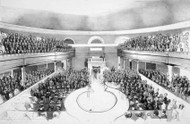Samuel Eastman excerpt from our latest book - Ministers of the Philadelphia Baptist Association
29th Sep 2021
Samuel Eastman: b. Oct. 1, 1788, Landaff, N.H.; d. Apr. 17, 1858, Elkhorn, Wis.; “The early part of his life was spent at home in agricultural pursuits, and in the district schools and academies in the vicinity. From a very early period he had a passionate fondness for books, and of course he eagerly read all that he could obtain” (Stout & Grout); at the close of the War of 1812, he undertook a journey to the West in 1815, visiting Cincinnati and Columbus, Ohio, etc.; while in Urbana, he contracted “the long fever,” which brought him near death; it was nearly a year before he had sufficiently recovered enough to leave there; he then journeyed down the Ohio and Mississippi Rivers to Natchez, Mississippi, “where he formed a partnership with the Rev. Benjamin Davis, in conducting a school on the then popular Lancasterian system” (Stout & Grout); . . . “Though long a careful Bible reader, he yet felt unprepared to enter fully into the work without further study and preparation. He accordingly left Natchez for Philadelphia, cheered by the commendations and blessings of the church” (Stout & Grout); . . . he studied for the ministry under William Staughton (q.v.), Sansom Street Baptist, Phila., 1817-1818, where he united in membership; . . . lic. Sept. 16, 1817, Sansom Street Baptist, Phila.; ord. as an evangelist, Sept. 22, 1818, Sansom Street Baptist, Phila.. . . he helped organize the Union (later Stanton Street) Baptist Church, of which he was pastor, July 1824-Wed., Nov. 24, 1830, . . . he resigned after contracting smallpox; the disease, however, “had no sooner run its course than he was seized with the liver complaint, and then with bleeding at the lungs, the loss of his voice, and the complete prostration of his physical powers. ‘This,’ writes brother Eastman, ‘rendered it improbable that I should ever again be able to speak in public. Under these circumstances,’ he continues, ‘I left the city of New York a mere wreck of humanity, and directed my feeble steps toward the granite hills of New Hampshire, anxious to find a calm resting-place or a speedy grave in the peaceful shades of my native place’ ” (Stout & Grout); . . . Shortly before his passing he wrote, “I am now in the sixty-ninth year of my age, blessed with an easy competence of the good things of this life, constantly reminded of my approaching dissolution by infirmities of body, calmly waiting the will of God till my change shall come, confidently relying on the merits of Christ for the salvation of my soul, turning off my thoughts from this troublesome world, and looking forward to the wonderful disclosures of the world to come”—Stout & Grout.

